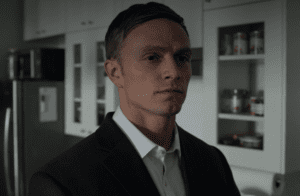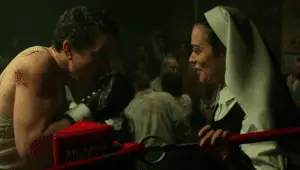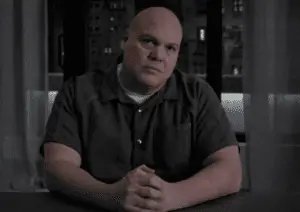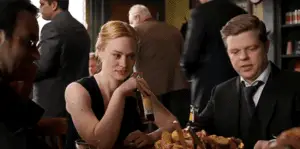This Daredevil fan has got a lot of words to spill about Season 3 of the Marvel Netflix show, which rose out of the ashes of Midland Circle (the messy Defenders and hit-and-miss Season 2) to make some of the greatest Marvel TV so far. And it’s in no small part thanks to getting back to excellent characters.
In Part 1, I explored why Matt is such a walking dumpster fire and that’s why I love him. And I enthused about great story choices made for Karen, possibly the best example of character development of the season. Here, I’ll cover some of the new characters this season, as well as an old favorite villain.
Part 2 of a 2-part article. Spoilers ahead!
Sister Maggie
Daredevil fans were excited to see the well-known comics character Sister Maggie appear in the show. Knowing a little about the comics storylines with Maggie, Matt’s mother that he never knew growing up, I was cautiously hopeful that this modern show wouldn’t succumb to some of the pitfalls that have happened with this character in the comics. In some storylines, she was demonized for leaving Jack and Matt when Matt was a baby. In a more recent storyline, post-partum depression was advanced as an explanation, finally giving more sympathy to the character.
This is the explanation that the show wisely goes with. We get a Sister Maggie backstory with Maggie as a young initiate to the convent, taking a detour in life when she meets and falls in love with Jack Murdock. In this version of the story, it isn’t that Maggie suddenly chooses to enter the convent after having a child. She returns to her original life plan, when her nun friends and mentor come to collect her, since Jack is at his wits’ end in the face of her depression. This gives some interesting ambiguity to comments Sister Maggie makes throughout the season about life choices and directions and regret. She clearly thinks she has made mistakes. Does she consider it a mistake to have left her training to marry Jack and bear his child? A mistake to have left Matt? Or both?
Before these revelations, however, Sister Maggie is a bit of a mystery. We don’t learn for quite a while that she’s Matt’s mother in this storyline. Until then, it isn’t clear, since the show only takes inspiration from the comics, and doesn’t strictly follow their stories. In the meantime, Sister Maggie nurses Matt back to health, curbs his worst self-destructive impulses (or at least chews him out afterwards, since she can’t exactly stop him), and gives him cynical life advice he sorely needs. She’s a hardened person who has seen it all and drinks hard liquor, a vice Matt accuses her of overindulging in. (A perfect example of Matt in a glass house, throwing stones.)
My favorite line from Sister Maggie, and a good candidate for my favorite line in the season, was in this exchange:
Matt: “D’you believe people can change?”
Sister Maggie [after a pause]: “I’m still holding out hope.”
In other words, in her five-plus decades of life, Sister Maggie has never seen anyone change. Her dialogue in the early episodes reveal her to be a deeply cynical person, who nonetheless remains true to her faith in humanity and in God. Joanne Whalley’s acting truly brought this tragic, realistic, and loveable character to life.
Secrets and guilt
Though it made sense for the plot, I found Sister Maggie less interesting as a character when her cynicism and sarcasm gave way to profound guilt. First, she blames herself a little too heavily for Bullseye’s murders in the newsroom, since she was the one who encouraged Matt to seek out his friends. She did so for Matt’s well-being, never imagining he would pull those friends into a plan to get testimony from the guy paid off to shank Fisk in prison. And that plan seemed risky but logical – I don’t even blame Matt for the newsroom massacre, much less Sister Maggie. Her guilt here seemed misplaced, and I thought it detracted somewhat from the emotional impact of her later, more important source of guilt.
That, of course, is how she left Matt, and never revealed herself as his mother. It’s an odd parallel to Matt/Daredevil, in a way – she helped raise Matt, in the orphanage, but kept her “secret identity” as his mother from him. Matt finds out who his mother is in a sad and powerful way, overhearing her prayer. His anger at her, and at Father Lantom for keeping her secret from him, is very understandable, and I thought was played well. But we got no more wisecracking, hard-drinking, cynical nun for the rest of the season, and I mourned that.
Not to say the subsequent scenes with Sister Maggie aren’t moving, and important: she confesses to Karen about being Matt’s mother and her guilt for abandoning him. She bravely misleads the corrupt FBI agents several times when Karen and Matt are hiding out in the church, quickly putting together that they can’t be trusted, and risking her own skin. And we get a glimpse of what Matt and her relationship might be like going forward, when Matt tentatively asks her if she can help him with the spiritual guidance that Father Lantom used to give him.
I missed that hard-edged side of Maggie, and I hope we’ll see it again in Season 4 (knock on wood that that gets made). Overall, though, I was more than pleased with this addition of another complicated, interesting female character to this show.
Wilson Fisk
I don’t know if I can gush anything new about Vincent D’Onofrio’s portrayal of Wilson Fisk that hasn’t already been gushed. His acting as Fisk is the kind of thing that can really irk you when you think about the unspoken rule that no superhero shows can win Emmys or the like, because D’Onofrio certainly deserves some kind of award.
In the first season, I initially didn’t like the character of Fisk. I didn’t see the point of following his slow, cautious courting of the art dealer, Vanessa Marianna. Nor of his love of art, meticulous choosing of cuff links, or expert making of omelettes. There was a genius slow build for this character, though. When Fisk’s childhood murder of his abusive father was finally revealed, with his emotional outburst, “I am not a monster!”, somehow D’Onofrio made that 12-year-old’s panic come through the face of this terrifying adult crime lord. And suddenly it all made sense: the obsessive clinging to all the trappings of civilization, of haute culture, are how Fisk desperately proves his own humanity to himself in every moment. It was brilliant, and I was thoroughly won over on this fascinating character.
Wilson Fisk is back in a similar excellent synergy of writing and acting here in Season 3. Once again, we see his ruthlessness combined with his deep vulnerability and insecurity that he rarely reveals – usually only in the presence of Vanessa.
Bending Dex to his will
I have two favorite things about Fisk in this season. One is his manipulation of ‘Dex’ Poindexter, a troubled FBI agent who we eventually see develop into the villain Bullseye. Fisk gives a couple of key speeches to Dex to win his trust and convince him to work for Fisk. In the first speech, Fisk takes a guess that Dex must be miffed about being investigated for shooting criminals that had surrendered, when Dex’s actions (at least from Fisk’s perspective) could be seen as heroic. Fisk’s adept psychological manipulation here was captivating. You could see Dex quickly get bent to his will. And it fits with everything we know about Fisk – how even in prison, in Season 2, he took methodical steps to become top dog and get everything he wanted. He’s a master at this stuff, and it is what makes him so scary.
Later on, Fisk has thoroughly dug through all the files on Dex he could get his hands on, including transcripts of therapy sessions Dex had as a kid. Fisk learns that, as a child, Dex killed his loving, supportive baseball coach in a fit of rage. Fisk’s manipulation after knowing all this is still skillful, although he has the benefit of all that information. Scarier is that he was willing to do so much research on the guy to find his weaknesses. And the synergy with his own life, with Dex murdering a parental figure at a young age, is not lost on Fisk.

Fisk’s personal art gallery
My second favorite thing about Fisk in Season 3 is a small detail that I find endlessly interesting, which is Fisk’s taste in art. I loved the storyline around ‘Rabbit in a Snowstorm’ in Season 1. Now, as Fisk outfits his lavish house-arrest penthouse, we get to see many other art pieces in his possession. Fisk is clearly attracted to 20th century abstract art, with an emphasis on bold colors and geometric shapes.
I did a quick check with some art historian friends, who identified most or all of the artists represented to be abstract expressionists from the New York School. One looks to be Excavation by Willem de Kooning. Another resembles a Franz Kline. And the red and black rectangles on a smoldering orange background is clearly designed to look like Mark Rothko. (I might be the only viewer who gasped, “Not the Rothko!” when it got destroyed in the final showdown.)
The show made a great choice to go with New York School artists. We already know that Fisk likes abstract art, and this is a famed school that grew out of the city around which Fisk bases his identity. It makes sense that Fisk would see this art as representing some of the highest culture to come out of New York.

Benjamin ‘Dex’ Poindexter (Bullseye)
I am of two minds about Dex. As comics villain origin stories go, this one was pretty good. But I just wasn’t captivated by this character. I was more interested in his use as a tool by Fisk than who he was in his own right.
Dex’s mental illnesses were a bit cliché for a villain: the sociopathic tendencies, the obsessive-compulsive traits. At the same time, these traits made a lot of sense for the character. Dex’s obsessive cleanliness was revealed to be a way he keeps and regains control after a lapse into rage and confusion (symbolized through audio like a swarm of buzzing bees drowning everything out.) His sociopathy, and his struggles to control it and learn empathy, gave him some depth. His therapist was an interesting character in her own right, despite a short amount of screen time.
On the other hand, Dex’s quasi-love interest and (Dex-appointed) moral compass, Julie, gets stalked and fridged for the storyline. Again, even though this plot was relatively well-done – Julie seemed like a real person, with normal responses, for example – this is ground that has been covered so many times in TV that it has gotten boring.
The one thing I really liked about Dex/Bullseye was his fighting abilities. Being a master at long-range weapons made him a perfect antagonist to Daredevil, who excels at close combat. Their battle in the newsroom made it clear that Matt was not prepared for Bullseye’s abilities, and Matt lost the fight. It is important to have your heroes lose sometimes, and Dex’s special skillset was a great way to accomplish this.
I was surprised at the end of the show that Dex did not die. Maybe I shouldn’t have been: a lot of villains in the MCU are spared to be used in further movies or seasons, especially white male villains (see e.g. Fisk, and Billy Russo from Punisher, vs. Killmonger from Black Panther; Cottonmouth, Bushmaster, and Mariah Dillard from Luke Cage). It was a striking scene at the end when, with experimental surgery, Dex prepares to come back as Bullseye.
But before that, Dex’s arc seemed to be bending toward death. In the calculus of action dramas, viewers were owed a tragic (or not so much) death on the part of the villains, to match the tragedies of Father Lantom and Ray Nadeem – not to mention minor characters like Julie, and Jasper, the Fisk-shivving would-be informant. Somehow, though, both Fisk and Bullseye made it, despite Bullseye’s life-threatening injury. I guess the actors signed a contract for longer than one season!
Nelson, Murdock and Page
Finally, there is so much to say about the original threesome we all loved from Season 1. Fans, at least in my corner of fandom, are enamored with the dynamic between Karen, Foggy and Matt, who enjoyed a heartwarming though booze-soaked friendship – it wasn’t for nothing that they were a popular OT3. There’s been a lot of angst over how this happy found family got so destroyed in Season 2, in part due to Matt’s battle with the Hand. We’ve been eager to see the three of them come back together, and Season 3 delivers it.

Best Damn Avocado
First, a little bit about Foggy Nelson. Fans of Foggy were pleased to see a big role for him this season. We got him running for District Attorney, in a bold attempt to push the other candidate, Blake Tower, to do something about Fisk. We were granted some comic relief in the form of interactions with Foggy’s best frenemy Brett Mahoney – who often seems like the only non-crooked cop in Hell’s Kitchen.
We finally got to meet Foggy’s family, with his brother Theo played by an actor that I’d believe was related to Elden Henson. Matt saves Foggy’s life in the newsroom fight, which was not highlighted much but seemed to add some balance, as Matt has saved Karen’s life multiple times. And Foggy’s relationship with Marci was explored, although I was disappointed that not much of Marci’s “shark in a skin suit” personality got to shine through; she was mostly relegated to the role of Supportive Girlfriend.
Foggy’s relationship with Matt has been through some ups and downs. Foggy reached a breaking point in Season 2 in particular, drawing a line in terms of how much crazy he could tolerate from Matt. In this season, he seems to have reverted to that intense loyalty that led him to unquestioningly follow Matt in quitting his lucrative law internship to start their own firm. This loyalty-to-a-fault does fit the characters’ backstory, and hearkened to Foggy’s role throughout the comics. But I would have liked to see more emphasis on what the transition involved for Foggy to turn back to trust and forgiveness towards Matt.
Reunion
Similarly, though it warmed my heard to see the happy reunion of Nelson, Murdock and Page – hanging out in the Nelson Family Meat Shop, drinking beers, and plotting opening a firm together again – I wondered if this happiness was completely earned. Yes, the three finally started working together again to counter the menace of Wilson Fisk. But there had still been friction between them over Matt’s reluctance to go through legal methods, versus doing it “his way” – the vigilante way. And all the hurts Matt has rained upon his friends seem swept aside in the end.
Plus, Matt appears surprisingly mentally stable by those final scenes (drinking whisky for “medicinal purposes” notwithstanding). At the start of the season, Matt was in religious, identity, and emotional crises, and he engaged in suicidal behavior. It seemed a little miraculous that Matt managed to climb out of his deep emotional hole without psychiatric help.
Then again, I could be succumbing to the trap I’ve fallen in before with the Marvel Netflix shows, and with Daredevil in particular: expecting too much realism and forgetting that it’s all a comic book. Matt physically survived a building collapse. Compared to that, it isn’t too hard to swallow that he mentally recovered from emotional collapse. That realism mistake I keep making is just a testament to the excellent world-building, writing and acting of this show, especially true of Season 3. The care and craft that’s been put into this show makes it feel real enough to believe.





